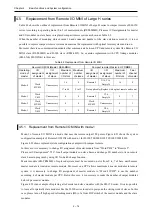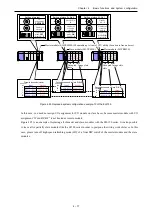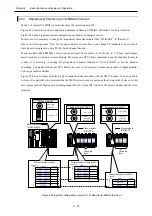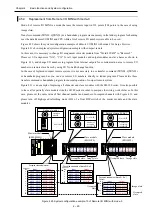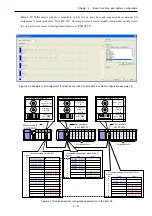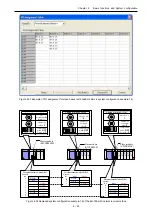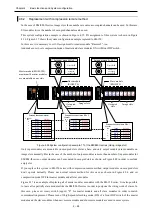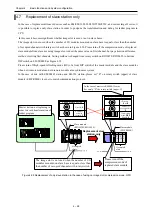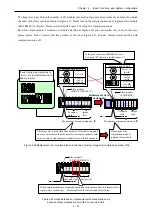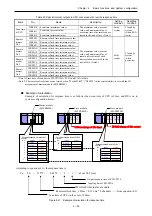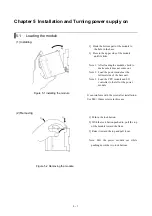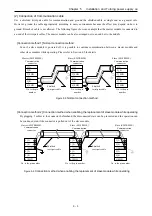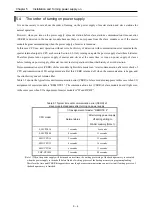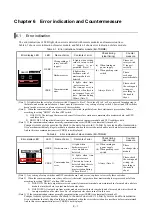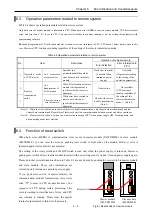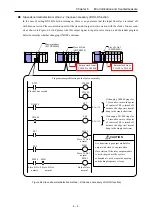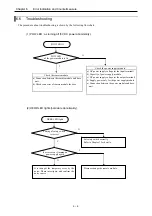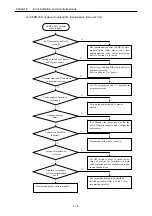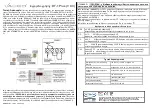
Chapter 4 Basic functions and System configuration
4 – 28
4.8 Response
time
The response time of remote I/O is calculated as follows.
■
Equivalent of response time
Response time: Ta [ms] = [Scan time of CPU]
+ [Remote refresh time] * 2
+ [I/O refresh time in slave module] * 2
+ [Input lag time]
+ [Output response time]
……………………………………………………
(4.1)
where each terms are explained as follows.
[Scan time of CPU]:
The actual measurement value of scan time is stored in WRF010 to WRF012 as shown in Table 4.3.
Please refer to EH-150 EHV-CPU PROGRAMMING MANUAL or EH-150 APPLICATION
MANUAL for execution time of each command.
[Remote refresh time]:
The remote refresh time changes by setting high-speed refreshing mode (HS).
When there are remote stations of conventional models, please use HS as turn off.
But remote refresh time can be shortened by setting HS turn on, when remote system consist of
compact remote only, that is, (master module: EH-TRMME, slave module: EH-TRMLE).
The remote refresh time is:
When HS is on,
[Remote refresh time] = 0.156ms * [number of occupied channels in master]
………
(4.2)
When HS is off
[Remote refresh time] = 0.338ms * [number of occupied channels in master]
………
(4.3)
The remote refresh time doesn’t depend on the number of slave stations.
The actual measurement value of remote refresh time is stored in special internal input of CPU
module as shown in Table 4.3 when I/O assignment of master module is “REMOTE 2”.
[I/O refresh time in slave module]:
It becomes 0.02ms or less. Because I/O refreshing of slave station is high speed, it isn’t influence in
the response time of remote system.
[Input lag time], [Output response time]:
Please refer to EH-150 EHV-CPU APPLICATION MANUAL or EH-150 APPLICATION MANUAL
for these times of I/O modules.
■
Reverse double-transmission check and response time
Compact remote system executes the check to the unit of one word (=16 bits) by reverse double-transmission.
It is a mechanism that only illegal word data is abandoned when the error is detected and correct data before
is maintained.
In this case, one remote refreshing time is added to response time in the detected word data.
Moreover, the display of communication error (CERR) doesn't appear to a remote module in this case.
Therefore the delay might occur even if LED in remote shows no error, and have enough margin for response
time in designing the system.
■
Number of occupied channels in master and remote refresh time
When number of occupied channels in master is equal to total of occupied channels of all slaves, the remote
refresh time is calculated by equations (4.2) and (4.3).
When number of occupied channels in master is more than total of occupied channels of all slaves, the
remote refresh time is calculated by equations (4.4) and (4.5) as follows. Because waiting times are added to
remote refresh time in the case of time-out error for unused channels, the remote refresh time becomes as
follows.
When HS is on,
[Remote refresh time] = 0.156ms * [number of occupied channels in master]
+ 0.5ms * [number of unused channels in master]
…………………
(4.4)
When HS is off,
[Remote refresh time] = 0.338ms * [number of occupied channels in master]
+ 0.5ms * [number of unused channels in master]
…………………
(4.5)

